Campus News
AcSIR Activities

| S.No. | Batch | Name of the student |
|---|---|---|
| 1 | 2012-August | Mr.Chinmay Haldar |
| 2 | Mr.Sheikh Mohammad Shakil Hashmi | |
| 3 | Mr.Sambuddha Mukherjee | |
| 4 | Mr.Somasish Bose | |
| 5 | Mr.Fozail Akhtar | |
| 6 | Mr.Abdurrahman | |
| 7 | Mrs.Harika Munagapati | |
| 8 | Ms.Titiksha Mishra | |
| 9 | Mr.Ravi Shankar | |
| 1 | 2013-January | Ms.Soumya Shukla |
| 2 | Mr.Padma Rao Bommoju | |
| 3 | Mr.Nilesh Kumar Jaiswara | |
| 4 | Mr.Anand Kumar Pandey | |
| 5 | Mr.Rajeev Kumar Yadav | |
| 6 | Mr. Ajay Malkoti | |
| 7 | Mr.Nikhil Kumar Baranval | |
| 8 | Ms.Arubam Khelen Chanu | |
| 1 | 2013-August | Mr. Sasi Kumar Reddy |
| 2 | Ms. Bandana Baruah | |
| 3 | Mr. Bhoopendra Singh | |
| 4 | Mr. Deepjyoti Goswami | |
| 5 | Ms.Sonalika Chowdhury | |
MoU’s signed during 2012-13
Between CGWB and CSIR‐NGRI
An agreement between Central Ground Water Board (CGWB) and CSIR-National
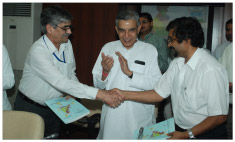 Dr. S C Dhiman, Chairman, CGWB and Dr.Mrinal Kanti Sen, Director, NGRI exchanging the signed contract documents in the presence of Shri Pawan Kumar Bansal, Hon’ble Union Minister of Water Resource and Parlimantary Affairs, Govt. Of India
Dr. S C Dhiman, Chairman, CGWB and Dr.Mrinal Kanti Sen, Director, NGRI exchanging the signed contract documents in the presence of Shri Pawan Kumar Bansal, Hon’ble Union Minister of Water Resource and Parlimantary Affairs, Govt. Of India
Geophysical Research Institute (CSIR-NGRI) for carrying out “Aquifer using advanced characterisation geophysical techniques in representative hydrogeological terrains in India” was signed on 21st May 2012 in the gracious presence of Shri Pawan Kumar Bansal, Hon’ble Union Minister of Water Resources and Parlimantary Affairs and Shri Vincent H Pala, Hon’ble Minister of State for Water Resources and Minority Afffairs. Shri D V Singh, Secretary Water Resources and Prof. S K Brahmachari, DG, CSIR were also present on the occasion. The agreement was signed by Dr. S C Dhiman, Chairman, CGWB and Professor Mrinal K Sen, Director, NGRI. This project will set the methodology for carrying out Aquifer Mapping for the entire country.
Between CSIR-NGRI and BRGM
The success of the collaboration between CSIR-NGRI and BRGM for 13 years has led to the extension of MoU for another two years. The 6th rider to the MoU was signed in two parts; by Mr. Francois Demarq, Director General of BRGM on November 20, 2012 in the presence of Dr. Shakeel Ahmed, Team leader (India) and Chief Scientist, CSIR-NGRI and by the Director, CSIR-NGRI on November 26, 2012 in the presence of Dr. A. Boisson, Team Leader (France) at Hyderabad.
CSIR-NGRI and Aarhus University, Denmark
On October 15th2012, a MoU was signed by CSIR-NGRI and Aarhus University, Denmark for carrying out Heliborne Transient Electromagnetic surveys for large scale Aquifer Mapping at the six pilot study areas. Prof. MK Sen, Director signed on behalf of CSIR-NGRI while Prof. Esben Auken on behalf of Aarhus University, Denmark in the gracious presence of HE Ambassador of Denmark, Secretary and Additional Secretary, MoWR, Govt. of India at New Delhi.
Between CSIR-NGRI and POWERGRID Corporation of India Limited CSIR-NGRI and POWERGRID have been collaborating for the past nine years for geophysical investigations of various earth electrode station (EES) sites for High Voltage Direct Current (HVDC) transmission in India. The collaboration between the two organizations has further been strengthened by extending the existing MoU for a period of another two years. This MoU was signed on January 15, 2013 by Shri M.M. Goswami, General Manager, (Engg.-HVDC), POWERGRID and Prof. Mrinal K. Sen, Director, CSIR-NGRI
CSIR-NGRI and POWERGRID have been collaborating for the past nine years for geophysical investigations of various earth electrode station (EES) sites for High Voltage Direct Current (HVDC) transmission in India. The collaboration between the two organizations has further been strengthened by extending the existing MoU for a period of another two years. This MoU was signed on January 15, 2013 by Shri M.M. Goswami, General Manager, (Engg.-HVDC), POWERGRID and Prof. Mrinal K. Sen, Director, CSIR-NGRI
Workshop on Heliborne Geophysics for Aquifer Mapping & signing of MoU
CSIR-NGRI is carrying out geophysical characterization of Aquifers in selected representative geological terrains of India in collaboration with Central Ground Water Board, MoWR, Govt. of India funded under the Hydrology Project – II. Heliborne Transient Electromagnetic method is the most suitable and cost-effective for large scale Aquifer Mapping.
Hydrogeophysics group, Aarhus University, Denmark has developed unique expertise of carrying out Heliborne TEM for groundwater exploration deploying a system called SKyTEM.
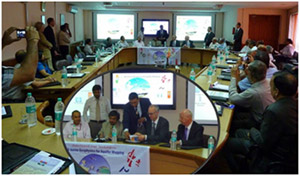 Aone day Indo-Danish workshop on Heli-borne Geophysics was organised where discussions on the advantages and limitations of heliborne TEM studies were discussed by the scientists of international repute.
Aone day Indo-Danish workshop on Heli-borne Geophysics was organised where discussions on the advantages and limitations of heliborne TEM studies were discussed by the scientists of international repute.
Events organised at NGRI 2012-13
National Technology Day
The Technology Day lecture was delivered by Dr.Chaitanyamoy Ganguly, President, Cameco India, on “Challenges of international cooperation in nuclear energy in India” on 11th May 2012. While tracing the success story of the development of nuclear energy technology in India from a humble beginning five decades back to the advance stage today, Dr. Ganguly spoke on the positive aspects of nuclear energy and dispelled several myths associated with it. Addressing the recent mishap at the Fukushima Nuclear Reactor in Japan due to an M 9.0
earthquake,he said that nuclear reactors installed by India at present are much safer with alternative safety mechanisms. Moreover, the conditions in Japan and in India are very different from the earthquake and tsunami point of view, the threat being minimal from these natural hazards in our country.
Dr. Ganguly explained in detail the three-stage nuclear fuel cycle and addressed the important issue of recycling technology which enhances the life of the fuel by several folds. He threw a challenge to the young scientists to come forward and explore new uranium resources in the country as we have very few and have to depend on other countries which is not very easy to get.
Dr. Ganguly also spoke of the pioneering efforts of the Indian scientists in developing the Prototype Fast Breeder Reactors in the country and hoped that in future, a judicious combination of Uranium with thorium will be used as the country has abundant thorium resources. In the last, he spoke on the very important issue of disposal of nuclear waste. He invited the earth science community to contribute on this aspect of nuclear technology which will greatly help our country and also provide leadership in the world community. He ended his talk with a message that the nuclear technology shall always be used for world peace and not the other way.
Brain Storming Discussion On 11 April 2012 M8.6 Sumatra-Indian Ocean Earthquake
In the wake of the 11th April 2012 M8.6 Sumatra-Indian Ocean earthquake a Brain Storming Session on great earthquakes was held on April 20, 2012 at NGRI. This discussion was necessitated as this earthquake threw several challenges on our understanding of great earthquakes, till now. Five presentations were made on different aspects of this earthquake. Dr.R. K. Chadha set the tone of the brain storming session by raising four major issues which this earthquake has violated, viz., that the recently ruptured areas will not rupture in near future by great earthquakes, areas where large earthquakes have not occurred for long time are due for next great earthquakes, triggering of one earthquake by another and regions with warm rocks/sediments will not give rise to great earthquakes.
Dr.N.Purnachandra Rao suggested the possibility of great earthquakes occurring on triple junctions and Dr.V.M.Tiwari correlated gravity anomalies with great earthquakes on a global scale. Dr.Vineet Gahalaut summarised his studies in the Andaman-Nicobar region after the Great Sumatra earthquake of 26th December 2004 and discussed the geodynamics of the region in the light of the 11th April 2012 earthquake. Dr. Kirti Srivastava presented the tsunami modelling results from possible great earthquake sources along Makran subduction zone in the west and Sumatra-Andaman in the east. The Brain Storming Session was attended by a large number of young researchers who have raised several questions including the possibility of the repeatability of such events in the future. Prof. Mrinal K Sen, encouraged the youngsters to participate in the discussions and asked them to probe deep into the mechanism of such great earthquakes which offer great opportunities to study this phenomenon.
Orientation lectures for Summer Interns
A series of orientation lectures in Earth Sciences were held at the CSIR - NGRI, Hyderabad on 22nd May 2012. The lectures were delivered by the Institute’s scientists for the benefit of young researchers in the Institute including the summer interns from different universities across India and students from Osmania and University of Hyderabad. Prof. Mrinal K Sen, , in his welcome address stressed the need to enthuse young minds to take up research as a career as the country needs more scientific researchers than management graduates. The orientation lectures covered a wide range of topics from the discovery of plate tectonics to the application of geophysical, geological and geochemical methods to explore natural resources for the benefit of the mankind. The areas addressed were from hydrocarbon exploration to gas hydrates and assessment of groundwater. In the final lecture, Prof. Sen dealt with a very important topic on the mistakes committed by non-native speakers of English while writing technical papers. He provided clues on writing good papers with correct English which improves the chances of getting a paper published in the most prestigious international journals.
The 122nd birthday celebration of Dr B.R.Ambedkar
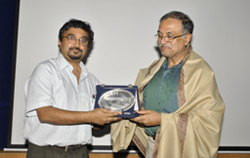 The 122nd birthday of Dr B.R.Ambedkar was celebrated at CSIR-NGRI on 23rd April, 2012. The function started with the welcome address and appraisal of the activities of the NGRI SC/ST welfare association. by Dr P.V.Sunder Raju, Senior Scientist. Prof Ramakrishna Ramaswamy, Vice Chancellor, University of Hyderabad was the Chief Guest and delivered a lecture on
“Inclusive policies- the route to excellence and relevance in acedemics.’ In his lecture, Prof. Ram quoted several examples from the past history about the role of women and dalits in the field of science and technology. Prof Mrinal K Sen, Diector NGRI presided over the function and spoke on the exemplary vision of Dr Ambedkar and importance and his scholarly writings especially about “The Constitution of India” and his struggle to uplift the downtrodden in the society. The function concluded with the vote of thanks by Mr Tirupathi.
The 122nd birthday of Dr B.R.Ambedkar was celebrated at CSIR-NGRI on 23rd April, 2012. The function started with the welcome address and appraisal of the activities of the NGRI SC/ST welfare association. by Dr P.V.Sunder Raju, Senior Scientist. Prof Ramakrishna Ramaswamy, Vice Chancellor, University of Hyderabad was the Chief Guest and delivered a lecture on
“Inclusive policies- the route to excellence and relevance in acedemics.’ In his lecture, Prof. Ram quoted several examples from the past history about the role of women and dalits in the field of science and technology. Prof Mrinal K Sen, Diector NGRI presided over the function and spoke on the exemplary vision of Dr Ambedkar and importance and his scholarly writings especially about “The Constitution of India” and his struggle to uplift the downtrodden in the society. The function concluded with the vote of thanks by Mr Tirupathi.
Western India Schools: Earthquake Lab Programme
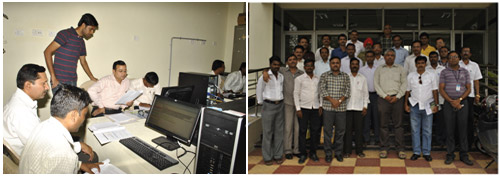
As part of the School-lab program sponsored by the Ministry of Earth Sciences, seismology labs were proposed to be set up in sixteen high schools in Satara, Sangli and Ratnagiri districts located around Koyna-Warna region of Maharashtra state. More than eighty school teachers from eight earthquake prone districts of Maharashtra have been trained so far. The objective of this project is to create awareness about earthquakes and hazard mitigation among school children. The fifth and final teacher-training program was organised for about 20 selected teachers from the above schools at NGRI, Hyderabad from May 2-4, 2012. The training program included lectures on basic seismology, tsunami, earthquake preparedness and fire safety. The lectures were followed by practical training on the operation of seismographs, seismic data retrieval and data analysis.
Visit of DG, CSIR to NGRI
 Professor Samir K. Brahmchari DG, CSIR, visited the institute on July 3, 2012 and addressed the staff members. He also released the book “Fractal Models in Exploration Geophysics: Application to Hydrocarcon Reservoir” authored by Dr. V.P. Dimri, CSIR Distinguished Scientist, Dr. Ravi Prakash Srivastava, and Dr. Nimisha Vedanti, Scientists of CSIR-NGRI. The book was published by Elsevier Science Publisher (July, 2012) as a
volume in the Handbook of Geophysical Exploration: Seismic Exploration Series.The book deals with the fundamental concepts of reservoir geophysics and reservoir simulation study and serves as a guide for researchers propagating the idea of applying fractals in exploration and geo-modelling. The book was well appreciated by eminent Professor Bjorn Ursin of Norwegian University of Science and Technology in his foreword. The book was dedicated to Dr. Hari Narain, former Director of CSIR-NGRI.
Professor Samir K. Brahmchari DG, CSIR, visited the institute on July 3, 2012 and addressed the staff members. He also released the book “Fractal Models in Exploration Geophysics: Application to Hydrocarcon Reservoir” authored by Dr. V.P. Dimri, CSIR Distinguished Scientist, Dr. Ravi Prakash Srivastava, and Dr. Nimisha Vedanti, Scientists of CSIR-NGRI. The book was published by Elsevier Science Publisher (July, 2012) as a
volume in the Handbook of Geophysical Exploration: Seismic Exploration Series.The book deals with the fundamental concepts of reservoir geophysics and reservoir simulation study and serves as a guide for researchers propagating the idea of applying fractals in exploration and geo-modelling. The book was well appreciated by eminent Professor Bjorn Ursin of Norwegian University of Science and Technology in his foreword. The book was dedicated to Dr. Hari Narain, former Director of CSIR-NGRI.
NGRI adopts a village under “CSIR 800”
One of the major important initiatives under CSIR 800 program “ TECHVIL” is to address the needs of villages all over the country through the CSIR rural technologies. CSIR-NGRI has taken up one such program at Mandollagudem Gram Panchayat near Choutuppal town of Nalgonda District of Andhra Pradesh. This village, located near the CSIR-NGRI Choutuppal Field Observatory is facing severe scarcity of water and high fluoride content in ground water.
CSIR-NGRI carried out hydrogeological and geophysical investigations in the Choutuppal field observatory, and drilled bore wells based on integrated studies on hard rock aquifers. Villagers of the Mandollagudem TECHVIL have approached NGRI for providing safe drinking water to three villages namely Mandollagudem, Toorpugudem and Singarayacheruvu.
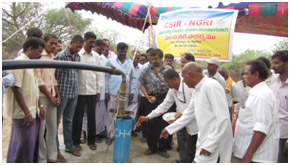 Prof. Mrinal K. Sen, Director, CSIR-NGRI inaugurating the Water Supply Scheme for CSIR-TECH Village – Mandollagudem
Prof. Mrinal K. Sen, Director, CSIR-NGRI inaugurating the Water Supply Scheme for CSIR-TECH Village – Mandollagudem
CSIR-NGRI agreed to their request and Prof. Mrinal K. Sen, Director, CSIR-NGRI inaugurated the water supply scheme on July 6, 2012 located at the Choutuppal observatory. Since then, the villagers are continuously drawing water from these borewells through an overhead tank. This activity has immensely helped CSIR-NGRI to bring in confidence among the TECHVIL people, which will pavethe way for the implementation of TECHVIL project in Mandollagudem gram panchayat.
Visit of the Honourable Governor of Andhra Pradesh to CSIR-TECH Village
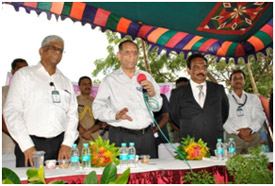 During his visit to Nalgonda district, Honorable Governor of Andhra Pradesh Shri E.S.L Narasimhan visited the Choutuppal Field Observatory on August 28, 2012 located near Mandollagudem TECHVIL. During his visit, the Hon. Governor enquired about the persistent water problem of the villages and discussed with the NGRI scientists about the water supply initiatives of CSIR-NGRI.
During his visit to Nalgonda district, Honorable Governor of Andhra Pradesh Shri E.S.L Narasimhan visited the Choutuppal Field Observatory on August 28, 2012 located near Mandollagudem TECHVIL. During his visit, the Hon. Governor enquired about the persistent water problem of the villages and discussed with the NGRI scientists about the water supply initiatives of CSIR-NGRI.
In his address, Hon`ble Governor indicated that Science and Technology interventions should largely benefit the society and address the common needs of the people. He asked CSIR-NGRI to take up more initiatives to provide sustainable water management solutions for the villages of Choutuppal Mandal of Nalgonda District. Dr Y.J.Bhaskar Rao, incharge Director explained the various activities taken up by NGRI for addressing the water problems of Nalgonda district.
CSIR Foundation Day Celebrations (28th September, 2012)
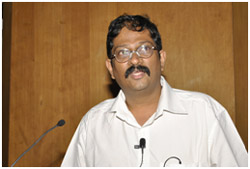 Professor Ananthanarayan gave an animated and self-contained account of the discovery of Higgs' boson, a particle hitherto hypothetical, which had to be conceived in order to explain the origin of mass in the framework of the 'standard model'." After presenting a short introduction to the experimental discovery, Prof Narayan gave a highly accessible description of the setting in which the discovery has taken place with an emphasis on the essential concepts.
Professor Ananthanarayan gave an animated and self-contained account of the discovery of Higgs' boson, a particle hitherto hypothetical, which had to be conceived in order to explain the origin of mass in the framework of the 'standard model'." After presenting a short introduction to the experimental discovery, Prof Narayan gave a highly accessible description of the setting in which the discovery has taken place with an emphasis on the essential concepts.
He concluded with what could possibly be the impact of this discovery on the landscape of elementary particle physics. After his talk, Prof. Ananthanarayan presented the cash awards to meritorious students of 12th class belonging to NGRI family and winners of various competitions. The chief guest also felicitated superannuated staff members (during Sept 2011- Aug 2012) and those completing 25 years of service at NGRI. The entire program was coordinated and conducted by the Information section. The program ended with a vote of thanks by Dr S.K. Ghosh, chief scientist.
NGRI opened for public
To commemorate the CSIR foundation day, the institute was kept open for public on 28th September, 2012 .This has provided an opportunity for the public, mainly students to get an idea of the activities being carried out by NGRI. About 7000 members visited the various labs and live demonstrations. The scientists and research scholars answered to the queries of the students with a lot of enthusiasm. A committee of three members visited the entire exhibition and selected the Tsunami group headed by Dr. Kirti Srivastava for best display award and Gas Hydrate group headed by Dr Kalachand Sain for best exposition. Seismology group headed by Dr Srinagesh got the special jury award.
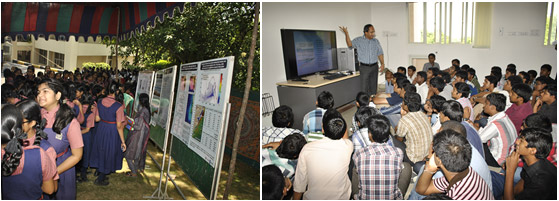
NGRI Foundation Day Celebrations
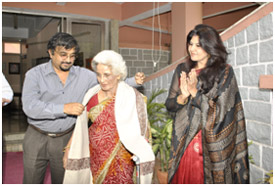 As a tribute to the contributions of Prof. Hari Narain, former Director, CSIR-NGRI, the NGRI library was rechristened as “Hari Narain Knowledge Resource Centre”. The ceremony was held on 12th October- the NGRI foundation day. Many former scientists, staff members as well as family members of Prof. Narain attended the function. Prof V.P.Dimri, CSIR Distinguished Scientist hailed the contributions of Dr Narain. Mrs. Saroj Narain was felicitated by Prof. Mrinal Sen, Director, NGRI on this occasion. Dr. Mallick, former scientist, NGRI dedicated a book authored by himself to Prof. Hari Narain and presented it to the NGRI library
As a tribute to the contributions of Prof. Hari Narain, former Director, CSIR-NGRI, the NGRI library was rechristened as “Hari Narain Knowledge Resource Centre”. The ceremony was held on 12th October- the NGRI foundation day. Many former scientists, staff members as well as family members of Prof. Narain attended the function. Prof V.P.Dimri, CSIR Distinguished Scientist hailed the contributions of Dr Narain. Mrs. Saroj Narain was felicitated by Prof. Mrinal Sen, Director, NGRI on this occasion. Dr. Mallick, former scientist, NGRI dedicated a book authored by himself to Prof. Hari Narain and presented it to the NGRI library
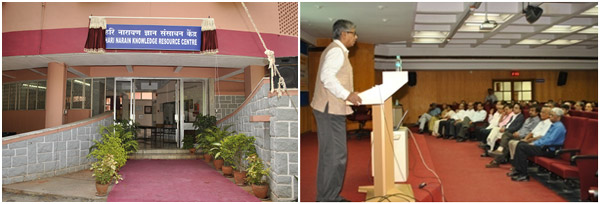
The NGRI Foundation Day lecture was delivered by Prof. Sushanta Datta Gupta, Vice-chancellor, Viswa Bharati University, Shantiniketan, West Bengal on the topic “The Tagore system of inclusive education”. He narrated the various aspects of education system at the university and the vision of Sri Ravindra Nath Tagore. He also discussed the simple physical explanations of symmetry theory in particle and its relation to the recent discovery of the “God particle”.
After the talk, Prof. Datta Gupta presented the mementoes to staff members of NGRI completing twenty five years of service at NGRI. Cash prizes instituted by Dr V.M. Maru, former scientist, NGRI were awarded to children of NGRI staff members securing highest marks in examinations. The function ended with a vote of thanks by Dr. D.S.Nagesh, Chief Scientist, NGRI.
High Performance Computation Facility
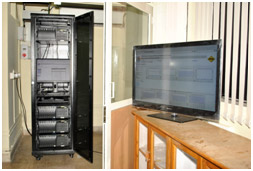 A State-of-the-art High Performance Computational Facility was setup at NGRI for carrying out computational studies, which was inaugurated on December 21, 2012.The cluster has 4 Nodes (One Master and Three Compute nodes). A Layer-3 managed gigabit interconnect (switch) was used to connect the nodes. The cluster allows ~ 50 users to login simultaneously.
A State-of-the-art High Performance Computational Facility was setup at NGRI for carrying out computational studies, which was inaugurated on December 21, 2012.The cluster has 4 Nodes (One Master and Three Compute nodes). A Layer-3 managed gigabit interconnect (switch) was used to connect the nodes. The cluster allows ~ 50 users to login simultaneously.
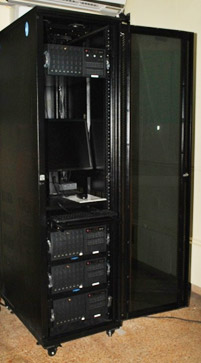 The nodes in the cluster are equipped with Intel E5-2600 Series Sandy Bridge Processors which has 8 cores (16 cores if HT enabled) and 20 MB Cache. Each node has two 2 processors, with a total of 16 cores per node (32 cores when HT enabled). In a nutshell the cluster has 128 cores in total. The cluster is powered with 1000 GB (I TB) of RAM and 4.7 TB of internal storage. A 3D – 42” LED Monitor is connected to the cluster. The Cluster was configured using open source cluster management softwares. It is MPI enabled with C/C++/f77/f90 open source compilers. Several open source geophysical data analysis software was installed in the computer. The facility will be used primarily to train students and young scientists the techniques of parallel processing.
The nodes in the cluster are equipped with Intel E5-2600 Series Sandy Bridge Processors which has 8 cores (16 cores if HT enabled) and 20 MB Cache. Each node has two 2 processors, with a total of 16 cores per node (32 cores when HT enabled). In a nutshell the cluster has 128 cores in total. The cluster is powered with 1000 GB (I TB) of RAM and 4.7 TB of internal storage. A 3D – 42” LED Monitor is connected to the cluster. The Cluster was configured using open source cluster management softwares. It is MPI enabled with C/C++/f77/f90 open source compilers. Several open source geophysical data analysis software was installed in the computer. The facility will be used primarily to train students and young scientists the techniques of parallel processing.
International symposium on “Response of Asian Rivers to Climate Change – Past, Present and Future Scenario”
An International symposium of IGCP-581 on “Response of Asian Rivers to Climate Change – Past, Present and Future Scenario” was organized at CSIR-National Geophysical Research Institute, Hyderabad during 14-16th November 2012. The symposium aimed at understanding the evolution of Asian river systems and their linkages with tectono-climatic processes. More than 100 delegates and students from India and abroad participated in this meeting and presented their recent results. Most of the papers presented during six sessions were related to the onshore and offshore sedimentary characteristics to trace the evolutionary history of Asian river systems.
The inaugural session was held on the morning of 15th November with Prof. S.K. Tandon. Former Pro V.C. Delhi University as chief guest and Shri A. Sundaramoorthy, Director General, Geological Survey of India, as guest of honour for the function. In his inaugural address, Prof. Tandon highlighted the importance of major rivers of Asia and their impact on human civilization through time. Shri. A. Sundaramoorthy mentioned the role of his organization in implementing International Geoscience Projects in India. Dr. S.S. Rai, Chief Scientist and Acting Director welcomed the delegates on behalf of the Director NGRI-CSIR. Dr. Masood Ahmad, Chief Scientist and convenor of the symposium stressed the significance of research related to the large river systems in understanding climate and tectonic processes operative in the past. Overall, 35 oral and 30 poster presentations were made during 15th and 16th November.
A large number of papers were presented related to the tectonic and climatic changes, in particular to the uplift of Himalaya and Tibetan Plateau. Several papers dealt with the evolution of Indian and East Asian monsoon systems and their linkages to tectonic changes in Himalaya. Stable and radiogenic isotopic and geochemical records were presented from various sedimentary archives to address problems related to Asian rivers. Some of the important recommendations made during the plenary session include comprehensive and coordinated studies on differential responses of large river systems, understanding of the short-term climate changes on high-resolution time scale and community sharing of data sets.

Indo –Norwegian conference on CO2 Injection for Enhanced Oil Recovery & Geological Sequestration (TOO MUCH TEXT???)
The first Indo-Norwegian conference on “CO2 injection for EOR and Geological Sequestration” was held at CSIR-National Geophysical Research Institute, Hyderabad during 26-28 November 2012, jointly organised by CSIR-National Geophysical Research Institute, Hyderabad, India and SINTEF Petroleum Research, Trondheim, Norway. The conference was inaugurated by Ms. Marianne Jensen, Science and Technology Counselor of Norway in Royal Norwegian Embassy New Delhi. She on behalf of the Ambassador of Norway to India expressed keen interest in continuing the ongoing project between India and Norway on Enhanced Oil Recovery (EOR) and CO2 capture and storage (CCS).
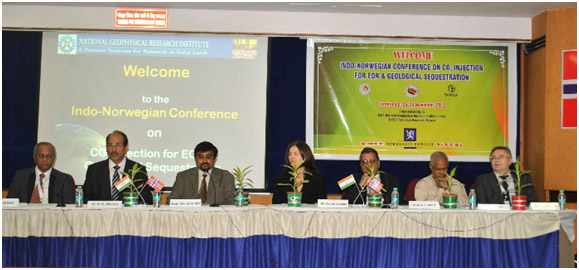
Prof. Mrinal K. Sen, Director NGRI, dealt with numerical modeling and simulation of potential reservoir for EOR and CCS by injecting CO2 and expressed his thrust to make NGRI a leader in this field. He also gave an opening lecture on the cutting edge technology of CO2 monitoring and reservoir characterization. Prof. V. P. Dimri, coordinator of the conference, expressed his thoughts on the EOR and CCS technology and related issues, laying emphasis on its grave need to save the country from environmental pollution. Dr. E. Desa, distinguished guest of honor, spoke about the CSIR tech villages and CSIR efforts to reach to 800 million people by providing the benefit of scientific developments. Dr. Idar Akervoll, senior researcher from SINTEF, Norway, and ongoing project coordinator, also emphasized on CCS to reduce pollution. Mr. R. S. Sharma, Head, Institute of Reservoir Studies, ONGC, Ahmedabad, expressed the need of collaboration between industry and research institutes to meet the demands of highly energy starving country like India. Prof. P. K. Banik, DG, Pandit Deendayal Petroleum University spoke about the human resource development and its better utilization to make the country self-reliant. This event was an outcome of long standing efforts by NGRI scientists and research scholars under the able guidance of Prof. V.P. Dimri, and Prof. Mrinal K. Sen, coordinators of the conference.
A total of 30 scientific papers were presented on various scientific sessions including the special theme ‘Enhanced Oil Recovery and Carbon capture & storage’, ‘Potential of Basalts for CO2 sequestration and its geochemical aspects’, ‘Unconventional Energy Resources’ and few general topics like seismic inversion, climate, micro-seismicity etc. Eight foreign delegates from Norway, USA and New Zealand, 27 Indian delegates from different renowned organizations, universities like ISM, Dhanbad, Delhi University, PDPU, GERMI etc and industries like ONGC, Reliance, CAIRN etc, and 27 delegates from CSIR-NGRI shared their knowledge during the conference. Eleven students from various institutes, universities of India participated in the poster session of this event. Three technical papers, among them two on the possible EOR model in the Ankleshwar, Gujarat field and one on possible CO2 saturation model in the Sleipner field, North Sea, were presented by the members of the project. Each session was followed by question-answer interaction session. Other delegates presented innovative methods and tools for EOR and CCS. Meetings to discuss upcoming projects from IRS, ONGC, Ahmedabad, CSIR-800, GERMI etc went on parallel to the conference. A colourful cultural evening was decorated by regional and folk dances by NGRI school children, classical dance by Prof (Mrs) Rima Chatterjee of ISM, Dhanbad and Fusion Music by an orchestra band. The technical session was folded by useful remarks by dignitaries on the theme of the conference why EOR and CCS are going to be very effective tools for developing country like India where demands of energy as well as the emission of CO2 in the atmosphere are rising day by day. The three-day program concluded by a geological field trip to the Nagarjuna Sagar cutting across different geological cross sections.
EU-INDIA STI Cooperation Days
The third edition of “EU-India Science Technology and Innovation Cooperation Days” was organised at CSIR-NGRI, Hyderabad on 8-9 November 2012, in order to showcase the good results of cooperation between Europe and India and to foster further STI cooperation. It is a joint event organised by the following projects and initiatives; New INDIGO and INDIA GATE, EURAXESS Links INDIA and India SI House in close cooperation with the CSIR-National Geophysical Research Institute.
The thematic focus is water-related research. Researchers working together in various types of projects (FP7, multilateral and bilateral) were invited to present their achievements. There was a very unique session on the networking with industries in a brokerage event to get further information about funding possibilities from the EU, India or bilateral programs.
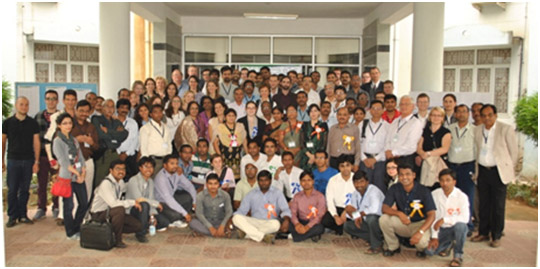
The event comprised of the following elements:
- Presentation of joint projects in water related topics
- Interventions by Policy makers and other stakeholder groups
- Poster presentations of scientific results by young researchers
- Networking friendly setting of the conference
- Organising a targeted brokerage event to assist future collaboration
- Awareness raising activities about funding opportunities offered by the EU, India, bilateral programmes and by industry
The event was inaugurated by Mr. Philippe de Taxi du Poet, the Scientific Atteche, European Delegation for India and Nepal, New Delhi and was attended by plus 200 participants from India and Europe. Prof. Aurelie Pachkoff from CNRS, France, Dr (Mrs) Poornima Rupal from CSIR, New Delhi, Prof. SS Rai, Acting Director, CSIR-NGRI, Dr. Arvind Kumar, DST, New Delhi, Dr John Claxon, EU also participated in the workshop.
International Workshop on Exploration & Exploitation of Shale Gas
 An international workshop on exploration and exploitation of Shale gas was organised during 19-20 Dec, 2012 at CSIR-NGRI by Society of Petroleum Geophysicists (SPG) Hyderabad Chapter under the aegis of SPG India. Sri Arun Kumar, Secretary, Oil Industries Development Board, was the chief guest of the conference while Prof. V.P. Dimri, CSIR Distinguished Scientist presided over the inaugural session. Dr.Bijendra Singh, President, SPG Hyderabad chapter welcomed the gathering. Sri Apurba Saha, Former President of SPG India was felicitated on this occasion for his significant contribution to the growth of SPG India. About 100 delegates participated in the conference and 22 papers were presented by invited speakers from USA, Malaysia and India.
An international workshop on exploration and exploitation of Shale gas was organised during 19-20 Dec, 2012 at CSIR-NGRI by Society of Petroleum Geophysicists (SPG) Hyderabad Chapter under the aegis of SPG India. Sri Arun Kumar, Secretary, Oil Industries Development Board, was the chief guest of the conference while Prof. V.P. Dimri, CSIR Distinguished Scientist presided over the inaugural session. Dr.Bijendra Singh, President, SPG Hyderabad chapter welcomed the gathering. Sri Apurba Saha, Former President of SPG India was felicitated on this occasion for his significant contribution to the growth of SPG India. About 100 delegates participated in the conference and 22 papers were presented by invited speakers from USA, Malaysia and India.
To name a few, scientific papers on petrographic aspects of shale gas, Indian perspective of shale gas exploration, use of stable isotopes in shale gas research, characteristics of selected Indian shales for estimation of potential were presented. Students from different universities were sponsored by SPG India to participate in the workshop and get an exposure of the latest trends in shale gas exploration.
The workshop ended with a panel discussion with the participation of representatives from different organisations chaired by Prof. Mrinal K Sen Director, NGRI. The panel recommended establishing a centre of excellence for shale gas research in India. The workshop was coordinated by N.S Dangwal, Secretary, SPG India, Dr. Kalachand Sain(NGRI) and Dr.AM. Dayal(NGRI).Workshop on Near Surface Geophysics
Workshop on Near Surface Geophysics was conducted by CSIR-NGRI from 27th to 29th of January, 2013. This workshop was inaugurated by the chief guest Shri P.S Parihar, Director, Atomic Minerals Directorate (AMD). Prof. V. P. Dimri, CSIR-Distinguished Scientist, was the guest of honour and Dr. S. K. Verma, Raja Ramanna Fellow, CSIR-NGRI was the advisor of the workshop. Prof. Mrinal K. Sen, Director, CSIR-NGRI highlighted the need for such kind of workshop on "Near Surface Geophysics" and elaborated on the necessity of geophysical methods and their applications to address the challenges in near surface studies.. The main themes covered in this workshop were: theoretical geophysical studies, mineral exploration, ground water studies, engineering geophysics, coastal salinity mapping, mining applications, seismic hazard zonation and waste disposal and monitoring of pollution plumes. Thirty students from different universities such as Kurukshetra University, IIT Kharagpur, Osmania University, Banarus Hindu University, Andhra University, ISM Dhanbad, Cochin University, KIIT University were sponsored by NGRI to attend the workshop and get an exposure of the latest trends in geophysics. Eighteen talks were delivered by eminent speakers from different institutions, NGRI and industries across India. All the scientific presentations were scheduled on 28th January in four sessions. The posters were presented on 28th and 29th January during tea breaks. On 29th January, 2013,a few geophysical equipments were demonstrated and the intricacies involved in the field studies were explained to the students in the NGRI campus. All the students were divided into three groups and then each group participated in the live demonstration of Horizontal Loop Electromagnetic Method (HLEM), Ground Penetrating Radar (GPR), Resistivity Imaging systems, 2-D High resolution Seismic surveys (HRSS) respectively. The workshop concluded with a panel discussion.Dr. T.Seshunarayana, Chief Scientist, CSIR-NGRIproposed vote of thanks .
13th PLANEX Workshop: 6-12 January 2013, CSIR-NGRI, Hyderabad
CSIR-NGRI organized the 13th PLANEX workshop "Impacts on Solar System Objects" from 6 to 12 January 2013 at NGRI Campus, Hyderabad. This workshop was composed of lectures and interactive sessions for four days, and a field visit to Lonar impact crater in Maharashtra. About 35 MSc/PhD/MTech/BTech students from various universities, IITs, engineering colleges attended the workshop. Dr. P. Senthil Kumar, Senior Scientist of CSIR-NGRI and Prof. S.V.S. Murty, Senior Professor of Physical Research Laboratory jointly convened the workshop. The participants spent three days at the Lonar crater where the resource persons illustrated the geology of the impact structure. The participants were given the text book "Planetary Surface Processes" written by H. Jay Melosh, and a copy of the special issue of the Elements Journal on the impact. Fourteen lectures were delivered covering various aspects of impact cratering processes taking place in various Solar System objects (planets, satellites and asteroids), and terrestrial impacts by experts both from national and international institutions. The participants also pursued a small research project on different aspects of the science of impact crators, mentored by experts.
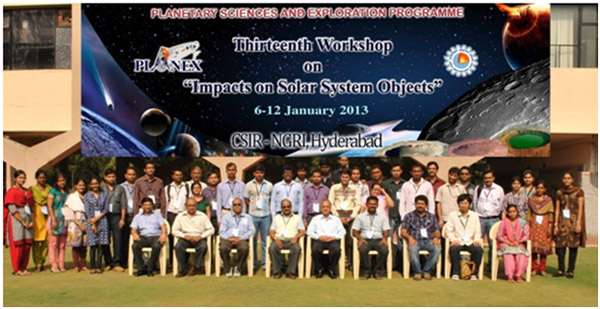
Prof. J.N. Goswami, Director, PRL, delivered a motivational lecture to the young participants. All the participants were benefitted by the workshop by gaining knowledge and insight on the meteorite impact processes and expressed their deep interest in considering planetary geology for their further research career.Prof. Mrinal K. Sen, Director, CSIR-NGRI distributed the participation certificates to all the participants.
Workshop/Training Course on “Geochemical Modelling in Igneous Petrogenesis:
A four day DST sponsored National Workshop/Training Course on “Geochemical Modelling in Igneous Petrogenesis: An Introduction to GCD Kit and R-Language” was organized at CSIR-National Geophysical Research Institute during 12-15 January, 2013. The training was offered by renowned computational experts and GCD kit code developers Prof. Vojtech Janousek from Czech Geological Survey and Charles University, Prague, Czech Republic, and Prof. Jean-François Moyen from Université Jean Monnet, Saint-Etienne, France. About 52 members including research scholars and a few young staff members from universities/R&D organizations from across the country attended this workshop.
 Training was imparted on the fundamentals of R-language, application of GCD kit in handling geochemical data sets, mass balance/mixing calculations,modelling the behaviour of trace elements and modelling strategies. Laptops with wi-fi connections provided to individual participants rendered the course effective in offering this hands-on-training program.
Training was imparted on the fundamentals of R-language, application of GCD kit in handling geochemical data sets, mass balance/mixing calculations,modelling the behaviour of trace elements and modelling strategies. Laptops with wi-fi connections provided to individual participants rendered the course effective in offering this hands-on-training program.
Renowned geochemists who have widely studied Indian rocks also added flavour to this program by imparting their studies on geochemical modelling to the participants.Prof. Rajamani (JNU, New Delhi) dwelt on Geochemical modelling in Igneous Petrogenesis while Prof. Mihir Deb (Delhi University) gave a detailed view on the application of geochemical data in metallogenic studies with special emphasis on gold mineralization. Prof.Santosh Kumar (Kumaun University, Nainital) delivered a lecture on viable models in magmatic processes, and Prof. K. Vijaya Kumar (SRTM, Nanded) extensively dealt on the mantle melting mechanisms using geochemical tracers. Course completion certificates were awarded to all the participants by Prof. Mrinal K Sen, Director, CSIR-NGRI, in the presence of Prof. S K.Tandon (Delhi University) and Dr. Umesh Sharma (DST, New Delhi).
Training Programme on Remediation Technology and Modeling of Assessment of Groundwater Contamination
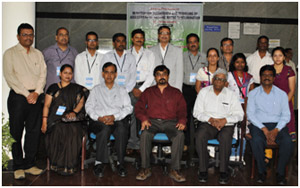 CPCB sponsored Training Programme on Remediation Technology and Modeling of Assessment of Groundwater Contamination was organized at the CSIR-National Geophysical Research Institute (NGRI), Hyderabad during January 21-25, 2013.
CPCB sponsored Training Programme on Remediation Technology and Modeling of Assessment of Groundwater Contamination was organized at the CSIR-National Geophysical Research Institute (NGRI), Hyderabad during January 21-25, 2013.
Professionals working in the field of environmental sciences including control, monitoring, legislative bodies and NGOs were trained to enhance their abilities of working knowledge and skills. The participants were mainlyscientists, Environmental Engineers, Scientific/Field Officers of Pollution Control Boards from different states. The objectives of the Training Programme were to explain about various remedial technologies, modelling and assessment of groundwater contamination due to organic and inorganic pollutants. Speakers from various academic institutes (i.e. IITs), Universities and R&D organizations including CSIR-NGRI Scientists were the resource personnel.
Prof. Mrinal K. Sen, Director, CSIR-NGRI, in his inaugural address, emphasized on the need of the training on advanced aspects of assessment of groundwater contaminationremediation and modelling.He has also spoken on the various projects of NGRI towards societal application apart from R & D activities. The training programme comprised of distinctlectures on remediationtechnologies and modeling of groundwater contamination followed by practical on lab-scale remedial methods, modelling and GIS mapping.
Validation Experiments For Chandrayaan – II
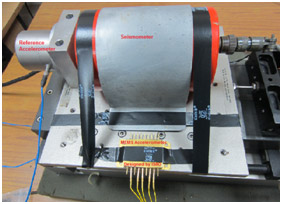 Under the Chandrayan II program, NGRI has carried out validation experiments on indigenously developed MEMS accelerometers by Indian Space Research organization (ISRO) with an objective to measure inertial variations of current and future spacecrafts and to measure moonquakes and vibrations of moon at landing site during February 7-8, 2013.
Under the Chandrayan II program, NGRI has carried out validation experiments on indigenously developed MEMS accelerometers by Indian Space Research organization (ISRO) with an objective to measure inertial variations of current and future spacecrafts and to measure moonquakes and vibrations of moon at landing site during February 7-8, 2013.
The experimental setup was designed in Testing and Calibration Lab headed by Dr H V S Satyanarayana, Senior Principal Scientist. The team comprised of Mr Thandan Babu Naik R, Raghavan R V, Dr D. Srinagesh and R S K Srinivasulu from NGRI and Mr Gaurav Saxena and Mr Selvaraj from ISRO
National Science Day
To commemorate the National Science Day,25 selected research students of NGRI presented their work through posters which was well attended by the scientists and students of the Institute. A fascinating lecture was delivered by Prof. Raghavendra Gadagkar from Center for Ecological Sciences and Center for Contemporary Studies, IISc Bangalore on ‘Science Education Indisciplined’!
Starting with the telling story of the Ant and the Grasshopper through a short Walt Disney film, he expanded on the development of different models of Knowledge Evolution in human society through time. Through examples from past and present, he explained how knowledge development and dissemination methods have gone from initial phases of anonymity and oral rendition to highly stylised documentation with formal credits and patents and is currently moving into the phase of cooperative contribution through crowd sourcing and other avenues.
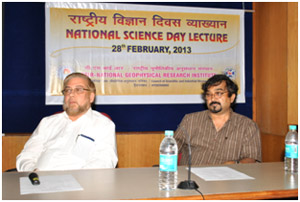 Prof. Raghavendra has developed his theory (in five themes) on the basis of studies conducted on social insects like ants, bees and wasps, to highlight the interconnections and interdependencies of the physical world around us. Thus, he extolled the breaking down of formal boundaries among different disciplines of science and indeed all other forms of knowledge including humanities and arts. This concept forms the strong basis of his novel teaching methods, which targets the holistic understanding and provides opportunities to the students to use their imagination and make up their own
constellation of disciplines and thus their own tree of knowledge Prior to the talk,Prof Mrinal K.Sen, Director, NGRI addressed the gathering and spoke on the significance of “National Science Day”.Dr G.Parthasarathy, chief scientist, introduced the chief guest to the gathering. The chief guest presented cash prizes to Mr R.Rajesh, Ms. Mehnaj and Ms. Karabi Talukdar for their best poster presentations. The function ended with a vote of thanks by Dr Kusumita Arora, Principal Scientist.
Prof. Raghavendra has developed his theory (in five themes) on the basis of studies conducted on social insects like ants, bees and wasps, to highlight the interconnections and interdependencies of the physical world around us. Thus, he extolled the breaking down of formal boundaries among different disciplines of science and indeed all other forms of knowledge including humanities and arts. This concept forms the strong basis of his novel teaching methods, which targets the holistic understanding and provides opportunities to the students to use their imagination and make up their own
constellation of disciplines and thus their own tree of knowledge Prior to the talk,Prof Mrinal K.Sen, Director, NGRI addressed the gathering and spoke on the significance of “National Science Day”.Dr G.Parthasarathy, chief scientist, introduced the chief guest to the gathering. The chief guest presented cash prizes to Mr R.Rajesh, Ms. Mehnaj and Ms. Karabi Talukdar for their best poster presentations. The function ended with a vote of thanks by Dr Kusumita Arora, Principal Scientist.